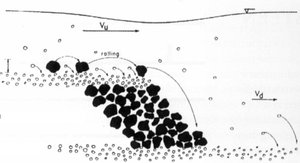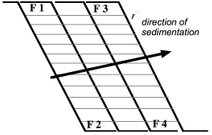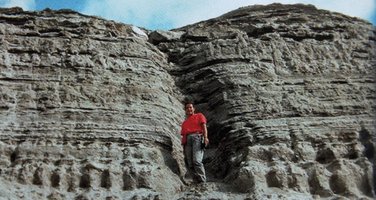KEPLER-SCIENCE
Origin of strata
Stratification: how fast can it go?
That is the big question. Slow forming of strata (on average) is essential for the monophylic model because time seems to be essential for the large changes from simple one celled life forms to the great diversity of complex multicellular life forms we see now. Usually an average speed of 20 cms per 5000 years is supposed. Fast forming of strata supports the idea of polyphyly. Catastrophies will cause a fast forming of strata as the aftermath of the eruption of Mount St Helens in 1980 shows (picture to the right: 4 meters formed in a matter of hours). The experiments of Berthault (embedded video) show that horizontal strata are not necesseraly formed by superposition: lateral forming and horizontal setting can go together. This can have great implications, especially for the relative dating of fossils: F4 being younger than F1 in the drawing below.
Forming of fossils
Fossils can be formed in a number of ways:
- Buried under sand or clay, closed off from oxygen (petrified fossils or only imprints)
- Caught in resin (insects in barnstone)
- In tar and asphalt marshes complete elepants can be found
- In acid peat marshes a kind of mummification takes place
- In dry caves or deserts they just dry out
- Caught in ice conservation including the flesh takes place
Geological column, index fossils and dating
All strata put into one thick pack of layers produces a geological column which appears in many textbooks - but it is a construction and cannot be found as such. Index fossils (only found in certain strata) are used to identify and date many strata because radiometric dating can only be used for a few types of rock.
Radiometric dating is questioned by some because of its assumptions: the clock at zero when the strata where formed, running with a known speed and no leaks involved. The speed of radio-active decay also depends on other factors like the speed of light. If the speed of light was higher in the past, the same is true of the speed of radio-active decay.
Proposing a flood model
Many observations support the idea of a global flood being reponsible for most strata (see workbook p 38/39). It is not easy to know how this happened - the scale is so much larger than what we are familiar with. Maybe something like the following happened:
- A cosmic event causing an impact of a meteorite and/or a comet
- Mega-tsunamis, a rising seabed (ruptured by the impacts) and sinking continents cause a major flooding
- Torrential rains, also caused by heated up oceans, cause landslides
- Whole ecosystems get uprooted and deposited elsewhere
- The lower the ecosystem (deep sea, coast underwater, coastline, lower slopes, etcetera) the lower it gets into the deposits
- The thickness of the layers causes high pressures > quick forming of fossils and coal and oil strata
- Cooling down of the seabed changes the balance again: new mountain ranges and very deep oceanic trenches are formed
- Continent drift could be the result of the quick gelogical processes involved (including volcanic eruptions)
- An ice age follows because of the warm oceans and cold poles
Dragons and dinosaurs
Very interesting are the stories on dragons - up to pretty recent times - and the soft tissue that has been found in dinosaur fossils. Link nr 12-14 supply more information about that and the video "Dragons or Dinosaurs" discusses the evidence.
LINKS:
- Download: salt formations
- Wikipedia on Flood geology and Polystrate trees
- Articles about Living fossils, Fresh fossils and Flood geology
- About: floating forests, or download: floating forest 1 and floating forest 2.
- About: radiometric dating
- More about the work of Berthault
- About maybe the best flood model
- Read: Rapidly forming oil supports Flood timeframe
- Read: Black rocks Red-Flag uniformitarion laws
- Read: ancient fossil looks like todays worms
- About soft tissue found in T. rex bones
- A different explanation of this soft tissue
- More soft tissue found, also featured in the Guardian
- About carbon-dated fossil tissue of T. rex: article 1, article 2 and video
- Geomorphology provides evidence for global flood
- How did plants and animals spread after the flood?
- Five challenges to creationist geology.
- For more Dutch links go to: 'aardlagen'





